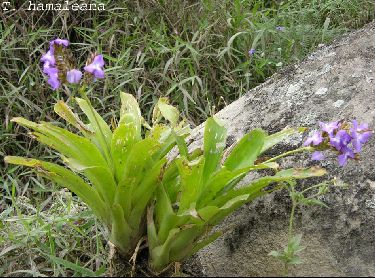
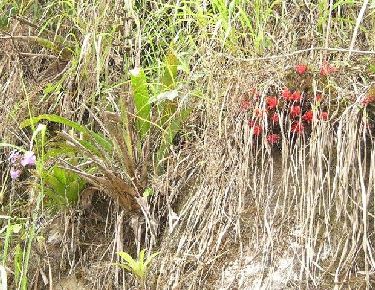
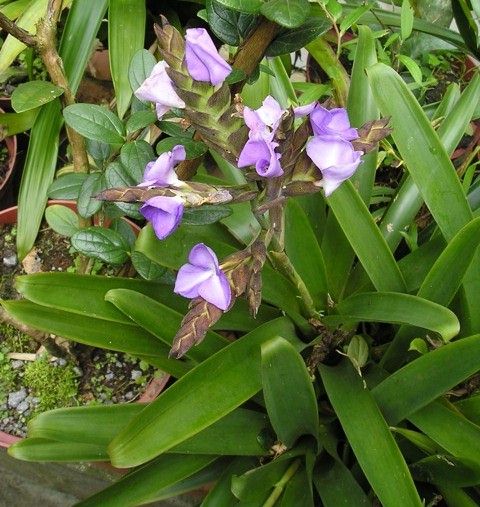

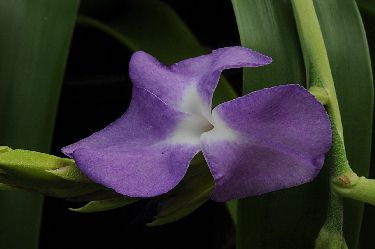
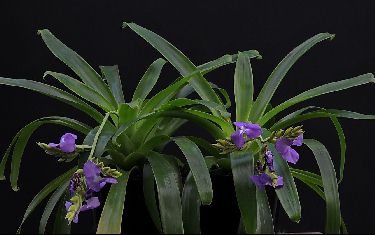
Tillandsia hamaleana E. Morren, Card. Chron. "1869",2: 460. 1869.
Wallisia hamaleana (E. Morren) E. Morren, Belg. Hortic.20: 97, pl. 5. 1870; nomen provis.
Tillandsia commelyna E. Morren ex E. Morren, Belg. Hortic. 20: 97. 1870; nomen in synon.
Phytarrhiza hamaleana E. Morren ex E. Morren, Belg. Hortic. 20: 97. 1870; nomen in synon.
Tillandsia platypetala Baker, Jour. Bot. London 26: 46. 1888. Type. El Cisne, Loja, Ecuador, Hartweg s n (K, GH photo), Jun 1841.
Tillandsia nubis Gilmartin, Phytologia 16: 161. 1968. Treated as a synonym of T. hamaleana in De Rebus I 1994
Desc from S&D p839-42
Plant stemless.
Leaves about 12 in a spreading rosette, 4 dm long;
Sheaths distinct, elliptic, covered with fine cinereous dark-centered scales;
Blades ligulate, subrounded and apiculate, 4 cm wide, flat, subdensely lepidote with fine cinereous scales, conclorous or purple-spotted.
Scape erect, 3-4 mm in diameter, terete, sparsely lepidote;
Scape-bracts erect and closely enfolding the scape, barely exceeding the internodes, elliptic, apiculate, subdensely appressed-Iepidote.
Inflorescence bipinnate from a few spikes, usually rather dense, about equaling the leaves; axes appressed-lepidote at first;
Primary bracts like the scape-bracts, about half as long as the lower spikes, membranaceous;
Spikes mostly sub¬erect, subsessile, elliptic, 4-9 cm long, 25-30 mm wide, strongly complanate, densely 4-12-flowered;
Rhachis straight, angled.
Floral bracts very broadly ovate, acute, 15-25 mm long, densely imbricate before anthesis but later enfolding the flowers and exposing the rhachis, about equaling the sepals, incurved and carinate toward apex, thin, nerved, green, drying stramineous, sparsely lepidote.
Sepals free, ecarinate, 12-20 mm long,
Petal-blades suborbicular, 15 mm in diameter, purple with a white eye;
Stamens deeply included, exceeding the pistil.
Type. Wallis s n in Morren Hortus (LG? n v). South America. In the absence of a specimen the species is well typified by the description and plate under Wallisia hamaleana.
DISTRIBUTION. Epiphytic in rainforest and rarely saxicolous. from near sea level to 2000 m alt, Ecuador.
ECUADOR. GUAYAS: Manglaralto, May 1959, Harling 5004 (S, US). ORO: Zaruma, La Chorita to Portovelo, 28 Aug 1923, Hitchcock 21159 (US); Quebrada Nudillo and Que¬brada Tambillo to Rio Luis, 13 Aug 1943, Steyermark 53859 (F, GH); Paccha to Puente Grande, 3°35' S, 79° 38' W, Aug 1943, Steyermark 54153 (F, GH); Cordillera de Guishaguina, Zaruma, 29 Aug 194 7, Espinosa E-1914 (US); Monte Cajamuna, 1951, Teuscher s n (US). PICHINCHA (?): Volcan Guanaxa, Sodiro 171/39-B (B, B photo 1249/12). COTOPAXI: Patalo, Aug 1944, Prescott 174 (US). CHIMBORAZO: Puma-cocha, Spruce s n (W); Huigra to Naranjapata, 17 Ju1 1923, Hitchcock 20676 (US); 19 Jun 1945, Camp E-3898 (NY, US). LOJA: El Tambo to La Toma, 3 Sep 1923, Hitchcock 21344 (GH, US); Chinche, San Pedro to Zaruma, 1939, Penland & Summers 1171 (GH); 29 Jul 1959, Harling 6132 (S, US).
TILLANDSIA HAMALEANA E. Morren by Prof. Dr. W. Rauh in Bromel Soc Bull 20(4): 75-6. 1970
(Syn: Wallisia hamaleana E. Morren,1870; Phytarhiza hamaleana E. Morren, 1870; Tillandsia commelyna E. Morr. ex E. Morren, 1870; Tillandsia platyphylla Baker, 1888)
On my expedition to northern Peru in 1967 I found on my way to Ayabaca at an altitude of 2600 m an old tree covered with a number of beautiful Tillandsias and Vrieseas. One of the most exciting Tillandsias among them was T. hamaleana, which has already flowered for the second time in our bromeliad greenhouse. As it has big, dark violet flowers similar to T. lindenii and T.cyanea, has a pleasant scent, and a very long flowering time (about one month), I believe that T. hamaleana may be of commercial value some day. At the moment this plant is very rare in bromeliad collections and nurseries, at least in Europe.
Tillandsia hamaleana is one of the green Tillandsias of medium size. It forms stemless rosettes of a height of 30- 40 cm including the inflorescence. The leaves are soft, fresh green, ligulate, 20-30 cm long, 3-4 cm broad and scarcely adpressed lepidote. The upper part of the leaves is curved back and tapering into a short acute tip. The sheaths are pale green and not contrasted with the blade. The inflorescence is erect and only a little bit longer than the leaves (about 30-40 cm). The scape is slender, 10-15 cm long and covered by the sheaths of the scape bracts. The inflorescence consists of mostly three spikes, a terminal one and two lateral spreading ones. Each spike sits on a short (0,5 cm) pedicel, is up to 6 cm long and 2,5 cm broad, and bears 8 to 12 flowers in two ranks. The primary bracts are shorter than the spikes, very thin, drying soon, red brown colored and gray lepidote. The flower bracts are sharply keeled in their upper part, red-brown, gray lepidote and thin. The big flowers have a diameter of 3-4 cm. They are deep violet when opening, with a white center ("eye"). The blades of the petals are broad and spread when fully developed. The color gradually changes to a pale violet-blue when the petals will become reflexed. Style and stamens are deep included. The blossoms stay open for several days. If you keep a flowering plant in your room, the whole room will soon be perfumed by the pleasant fragrance of the flowers. T. hamaleana is closely related to the Ecuadorian T. dyeriana, which has smaller flowers and white in color. It, too, diffuses an intensive and pleasant scent, similar to that of T. hamaleana. The culture of this plant is easy in a pot with a mixture of peat and sand, but grows equally well as an epiphyte mounted on grape-wood. Like all green Tillandsias, T. hamaleana does not need much light but requires high humidity.
From S&D key
17. Floral bracts carinate, incurved. Ecuador.
18. Floral bracts 30-34 mm long, much exceeding the sepals; leaf-blades 20 mm wide. => 183. T. dyeriana.
18: Floral bracts 12-21 mm long, about equaling the sepals; leaf-blades 30-45 mm wide.
19. Floral bracts imbricate at anthesis and covering much of the rhachis. => 184. T. hamaleana.
19. Floral bracts inrolled about the flowers at anthesis and wholly exposing the rhachis. => 185. T. nubis.
Tillandsia nubis Gilmartin, Phytologia 16: 161. 1968.
A T. dyeriana Andre, cui affinis, partibus omnibus minoribus, spicis angustioribus bracteis florigeris sepalis non superatis differt.
Treated as a synonym of T. hamaleana in De Rebus I 1994
Desc from S&D
Plant stemless, flowering to 48 cm high.
Leaves to 25 cm long, often tinged with purple;
Sheaths 9 cm long, 45-55 mm wide, pale brown;
Blades ligulate, 30-45 mm wide, acute to apiculate.
Scape erect, 3-4 mm in diameter;
Scape-bracts 5-7 cm long, strict, imbricate.
Inflorescence laxly bipinnate or subtripinnate, pyramidal, 24 cm long, 13 cm in diameter, glabrous;
Primary bracts 25-40 mm long, 9-10 mm wide;
Spikes ascending, oblong, 6-9 cm long, 3-4 cm wide, 8-14-flowered, the stipe naked, 14-30 mm long;
Rhachis nearly straight.
Floral bracts spreading at anthesis, ovate, acute, 14-21 mm long, carinate, incurved, chartaceous, nerved;
Flowers sessile.
Sepals free, broadly elliptic, acute to acuminate, 15-18 mm long, 5-7 mm wide, ecarinate, coriaceous, even;
Petals to 45 mm long, blades suborbicular, 12 mm wide, violet;
Stamens included, exceeding the pistil; ovary 2-3 mm long; style 1-1.5 mm long.
Capsule cylindric, 3 cm long.
Type. Naundorff s n (holotype US), Tandapi, Pichincha, Ecuador, cultivated by Marnier-Lapostolle 55.
DISTRIBUTION. Cloud forest, 540-1500 m alt, central Ecuador.
ECUADOR. CANAR: Guayaquil to El Tambo, 14 Aug 1965, Gilmartin 1186 (US). PROVINCE UNKNOWN: Selva Negra, western Ecuador, Naundorff s n (US), cultivated by Milstein s n, Dec 1967.
Detail from Gilmartin 1972
10. Tillandsia nubis Gilmartin, 1968 (Phytologia vol. 16) pp. 161-162.
A T. dyeriana Andre, cui affinis, partibus omnibus minoribus, spicis angustioribus, bracteis florigeris sepalis non superatis differt.
PLANT to 45 cm tall;
LEAVES at least to 24 cm long, blades ca. 3.0-4.5 cm wide, lingulate, apex acute to apiculate, sheath ca. 9.0 cm long by 4.5-5.5 cm wide, pale brown, blade and sheath often with some purple when living;
SCAPE 35-48 cm long with inflorescence, 3-4 mm in diameter;
SCAPE BRACTS 5.0-7.0 cm long, strict, imbricate below, scarcely so above;
INFLORESCENCE ca. 24 cm long by ca. 13 cm in diameter, mostly bipinnate, may be partly tripinnate, lax, pyramidal, glabrous;
PRIMARY BRACTS 2.5-4.0 cm long by 0.9-1.0 cm wide;
SPIKES 6.0-9.0 cm long by ca. 3.0-4.0 cm wide, ascending, with stipe 1.4-3.0 cm long, no sterile bracts, having 8 to 14 flowers, spike-rhachis nearly straight, distance between spikes 2.0-4.0 cm;
FLORAL BRACTS 1.4-2.1 cm long by 8 mm wide, spreading at 75°-90° angle with rhachis at anthesis, carinate, nerved, apex acute, ap¬parently glabrous without and within, papery, not imbricate;
SEPALS 1.5-1.8 cm long by 5-7 mm wide, about equaling floral bracts, broadly elliptic, coriaceous, glabrous without and within, acute to attenuate, not nerved, ecarinate;
PETALS to 4.5 cm long, blades ca. 1.2 cm wide, violet;
OVARY 2-3 mm long by 1.2 mm wide, style 1.0-1.5 mm long, shorter than starnens, distance between flowers 4-6 mm, probable flowering time March-June.
MATERIAL EXAMINED: Naundorff s. n. (US, TYPE) Tandapi, "palma de pais", cultivated by Marnier-Lapostolle no. 55, Prov. Pichincha, ca. 1500 m, 22 March 1966; .AJG 1186 (US) cloud forest, road between Guayaquil and El Tambo, Prov. Canar, ca. 920 m, 14 Aug. 1965.
NOTES: The resemblance to T. dyeriana Andre is strong and especially so if one does not take into consideration the dimensions of the floral parts. The spikes, for example, of T. dyeriana are at least 5.5 cm wide at anthesis and the spikes of T. nubis AJG are not more than 3.0 cm wide at anthesis. An additional feature which distinguishes these two is the relative lengths of the sepals and floral bracts. The floral bracts of T. dyeriana conspicuously over-reach the sepals; the floral bracts of T. nubis equal or are exceeded by the sepals. The collection area for T. dyeriana is coastal Ecuador. The collections sites for T. nubis are the Andes from ca. 900-2000 m altitude. Lehmann 26 (B) which was determined by Mez to be T. dyeriana (Mez, 1935, p. 576) and collected from near Quito may also be a representative of this species. I have not had the opportunity to examine this Lehmann specimen.
Protologue
Tillandsia platypetala Baker, Jour. Bot. London 26: 46. 1888. Type. El Cisne, Loja, Ecuador, Hartweg s n (K, GH photo), Jun 1841.
- 167. T. platypetala, n. sp.
Leaves few in a rosette, erect, lorate from a large dilated ovate base 2 ½ in. diam., above a foot long, 1 ½ - 1 ¾ in. broad, obtuse, thin, flexible subglabrous.
Peduncle as long as the leaves;
bract-leaves small, scariose, entirely adpressed.
Inflorescence a dense panicle 3-4 in. long and broad;
branches 4-5, dense, erecto-patent;
branch-bracts small, scariose, ovate;
flower-bracts ovate-oblong; 3/4 in. long,
Calyx reaching to the tip of the bract;
sepals oblong, very convolute and imbricated.
Petal-blade obovate-cuneate, ½ in. long and broad.
Stamens and style not exserted from thc calyx.
Hab. Ecuador; mountains of El Cisne, Hartweg!
Tillandsia hamaleana E. Morren, Card. Chron. "1869",2: 460. 1869.
Wallisia hamaleana (E. Morren) E. Morren, Belg. Hortic.20: 97, pl. 5. 1870; nomen provis.
Tillandsia commelyna E. Morren ex E. Morren, Belg. Hortic. 20: 97. 1870; nomen in synon.
Phytarrhiza hamaleana E. Morren ex E. Morren, Belg. Hortic. 20: 97. 1870; nomen in synon.
Tillandsia platypetala Baker, Jour. Bot. London 26: 46. 1888. Type. El Cisne, Loja, Ecuador, Hartweg s n (K, ("H photo), Jun 1841.
Ti11andsia nubis Gilmartin, Phytologia 16: 161. 1968. Treated as a synonym of T. hamaleana in De Rebus I 1994
Desc from S&D p839-42
Plant stemless.
Leaves about 12 in a spreading rosette, 4 dm long;
Sheaths distinct, elliptic, covered with fine cinereous dark-centered scales;
Blades ligulate, subrounded and apiculate, 4 cm wide, flat, subdensely lepidote with fine cinereous scales, conclorous or purple-spotted.
Scape erect, 3-4 mm in diameter, terete, sparsely lepidote;
Scape-bracts erect and closely enfolding the scape, barely exceeding the internodes, elliptic, apiculate, subdensely appressed-Iepidote.
Inflorescence bipinnate from a few spikes, usually rather dense, about equaling the leaves; axes appressed-lepidote at first;
Primary bracts like the scape-bracts, about half as long as the lower spikes, membranaceous;
Spikes mostly suberect, subsessile, elliptic, 4-9 cm long, 25-30 mm wide, strongly complanate, densely 4-12-flowered;
Rhachis straight, angled.
Floral bracts very broadly ovate, acute, 15-25 mm long, densely imbricate before anthesis but later enfolding the flowers and exposing the rhachis, about equaling the sepals, incurved and carinate toward apex, thin, nerved, green, drying stramineous, sparsely lepidote.
Sepals free, ecarinate, 12-20 mm long,
Petal-blades suborbicular, 15 mm in diameter, purple with a white eye;
Stamens deeply included, exceeding the pistil.
Type. Wallis s n in Morren Hortus (LG? n v). South America. In the absence of a specimen the species is well typified by the description and plate under Wallisia hamaleana.
DISTRIBUTION. Epiphytic in rainforest and rarely saxicolous. from near sea level to 2000 m alt, Ecuador.
ECUADOR. GUAYAS: Manglaralto, May 1959, Harling 5004 (S, US). ORO: Zaruma, La Chorita to Portovelo, 28 Aug 1923, Hitchcock 21159 (US); Quebrada Nudillo and Que¬brada Tambillo to Rio Luis, 13 Aug 1943, Steyermark 53859 (F, GH); Paccha to Puente Grande, 3°35' S, 79° 38' W, Aug 1943, Steyermark 54153 (F, GH); Cordillera de Guishaguina, Zaruma, 29 Aug 194 7, Espinosa E-1914 (US); Monte Cajamuna, 1951, Teuscher s n (US). PICHINCHA (?): Volcan Guanaxa, Sodiro 171/39-B (B, B photo 1249/12). COTOPAXI: Patalo, Aug 1944, Prescott 174 (US). CHIMBORAZO: Puma-cocha, Spruce s n (W); Huigra to Naranjapata, 17 Ju1 1923, Hitchcock 20676 (US); 19 Jun 1945, Camp E-3898 (NY, US). LOJA: El Tambo to La Toma, 3 Sep 1923, Hitchcock 21344 (GH, US); Chinche, San Pedro to Zaruma, 1939, Penland & Summers 1171 (GH); 29 Jul 1959, Harling 6132 (S, US).
From S&D key
17. Floral bracts carinate, incurved. Ecuador.
18. Floral bracts 30-34 mm long, much exceeding the sepals; leaf-blades 20 mm wide. => 183. T. dyeriana.
18: Floral bracts 12-21 mm long, about equaling the sepals; leaf-blades 30-45 mm wide.
19. Floral bracts imbricate at anthesis and covering much of the rhachis.=> 184. T. hamaleana.
19. Floral bracts inrolled about the flowers at anthesis and wholly exposing the rhachis. => 185. T. nubis.
Tillandsia nubis Gilmartin, Phytologia 16: 161. 1968. Treated as a synonym of T. hamaleana in De Rebus I 1994
Desc from S&D
Plant stemless, flowering to 48 cm high.
Leaves to 25 cm long, often tinged with purple;
Sheaths 9 cm long, 45-55 mm wide, pale brown;
Blades ligulate, 30-45 mm wide, acute to apiculate.
Scape erect, 3-4 mm in diameter;
Scape-bracts 5-7 cm long, strict, imbricate.
Inflorescence laxly bipinnate or subtripinnate, pyramidal, 24 cm long, 13 cm in diameter, glabrous;
Primary bracts 25-40 mm long, 9-10 mm wide;
Spikes ascending, oblong, 6-9 cm long, 3-4 cm wide, 8-14-flowered, the stipe naked, 14-30 mm long;
Rhachis nearly straight.
Floral bracts spreading at anthesis, ovate, acute, 14-21 mm long, carinate, incurved, chartaceous, nerved;
Flowers sessile.
Sepals free, broadly elliptic, acute to acuminate, 15-18 mm long, 5-7 mm wide, ecarinate, coriaceous, even;
Petals to 45 mm long, blades suborbicular, 12 mm wide, violet;
Stamens included, exceeding the pistil; ovary 2-3 mm long; style 1-1.5 mm long.
Capsule cylindric, 3 cm long.
Type. Naundorff s n (holotype US), Tandapi, Pichincha, Ecuador, cultivated by Marnier-Lapostolle 55.
DISTRIBUTION. Cloud forest, 540-1500 m alt, central Ecuador.
ECUADOR. CANAR: Guayaquil to El Tambo, 14 Aug 1965, Gilmartin 1186 (US). PROVINCE UNKNOWN: Selva Negra, western Ecuador, Naundorff s n (US), cultivated by Milstein s n, Dec 1967.
Detail from Gilmartin 1972
10. Tillandsia nubis Gilmartin, 1968 (Phytologia vol. 16) pp. 161-162.
A T. dyeriana Andre, cui affinis, partibus omnibus minoribus, spicis angustioribus, bracteis florigeris sepalis non superatis differt.
PLANT to 45 cm tall;
LEAVES at least to 24 cm long, blades ca. 3.0-4.5 cm wide, lingulate, apex acute to apiculate, sheath ca. 9.0 cm long by 4.5-5.5 cm wide, pale brown, blade and sheath often with some purple when living;
SCAPE 35-48 cm long with inflorescence, 3-4 mm in diameter;
SCAPE BRACTS 5.0-7.0 cm long, strict, imbricate below, scarcely so above;
INFLORESCENCE ca. 24 cm long by ca. 13 cm in diameter, mostly bipinnate, may be partly tripinnate, lax, pyramidal, glabrous;
PRIMARY BRACTS 2.5-4.0 cm long by 0.9-1.0 cm wide;
SPIKES 6.0-9.0 cm long by ca. 3.0-4.0 cm wide, ascending, with stipe 1.4-3.0 cm long, no sterile bracts, having 8 to 14 flowers, spike-rhachis nearly straight, distance between spikes 2.0-4.0 cm;
FLORAL BRACTS 1.4-2.1 cm long by 8 mm wide, spreading at 75°-90° angle with rhachis at anthesis, carinate, nerved, apex acute, ap¬parently glabrous without and within, papery, not imbricate;
SEPALS 1.5-1.8 cm long by 5-7 mm wide, about equaling floral bracts, broadly elliptic, coriaceous, glabrous without and within, acute to attenuate, not nerved, ecarinate;
PETALS to 4.5 cm long, blades ca. 1.2 cm wide, violet;
OVARY 2-3 mm long by 1.2 mm wide, style 1.0-1.5 mm long, shorter than starnens, distance between flowers 4-6 mm, probable flowering time March-June.
MATERIAL EXAMINED: Naundorff s. n. (US, TYPE) Tandapi, "palma de pais", cultivated by Marnier-Lapostolle no. 55, Prov. Pichincha, ca. 1500 m, 22 March 1966; .AJG 1186 (US) cloud forest, road between Guayaquil and El Tambo, Prov. Canar, ca. 920 m, 14 Aug. 1965.
NOTES: The resemblance to T. dyeriana Andre is strong and especially so if one does not take into consideration the dimensions of the floral parts. The spikes, for example, of T. dyeriana are at least 5.5 cm wide at anthesis and the spikes of T. nubis AJG are not more than 3.0 cm wide at anthesis. An additional feature which distinguishes these two is the relative lengths of the sepals and floral bracts. The floral bracts of T. dyeriana conspicuously over-reach the sepals; the floral bracts of T. nubis equal or are exceeded by the sepals. The collection area for T. dyeriana is coastal Ecuador. The collections sites for T. nubis are the Andes from ca. 900-2000 m altitude. Lehmann 26 (B) which was determined by Mez to be T. dyeriana (Mez, 1935, p. 576) and collected from near Quito may also be a representative of this species. I have not had the opportunity to examine this Lehmann specimen.